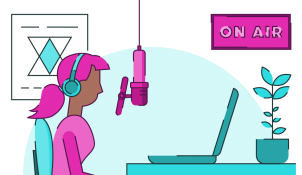At some point, most of us will be required to record ourselves speaking, whether it’s recording a podcast, adding voice-over to a presentation, or creating an on-demand webinar. Like most people, you probably don’t enjoy hearing yourself speaking on ‘tape’, but here are a few ways to make sure that everyone else will.
The kit
Most new desktops and laptops (in fact virtually everything you might carry away from a large electrical retailer) are bundled with a ‘goodie’-bag of peripherals that will almost certainly contain a headset with microphone. The best thing you can do with this free headset is recycle it without even taking it out of its plastic bag. Similarly, the built-in array of $1 microphones drilled into the frame of your $1500 laptop might help you through a Skype call in a pinch, but if you’re doing any kind of serious voice recording you need to drop some dollars on a decent headset. I strongly recommend you find a set with a ‘boom’ mic attachment (the microphone is perched on an adjustable arm fixed to the side of the headset) rather than a standalone microphone. Having the microphone attached to your head means it’s easy to find the optimum positioning of the microphone relative to your lips, and once fixed in place the angle and distance will be consistent (unlike a fancy desktop or lapel microphone which requires rigor mortis-like control of the upper body).
My personal favourite mid-range set is the BeyerDynamic MMX2 which delivers really impressive recording and playback quality for the price. A cheaper option is the Sony DR-350USB – this performs adequately but features a detachable microphone tube that’s easily lost. As well as an adjustable microphone arm, look for a spongy pop-shield on the microphone itself and a USB adapter. The USB connection is important because it means the audio signal remains in digital form all the way to the application, instead of being converted to analogue during the process when you plug in via the standard 3.5 mm jack-plugs.
The script
If you’re recording a conversational podcast, this won’t apply – but if you’re recording any kind of voice-over, you simply cannot ‘wing’ it. You can try, but it will take all afternoon and something nearby will get smashed in the process. Even if you have a great deal of experience and speak frequently about your topic, you can’t tell what you think until you see what you say, to paraphrase E.M.Forster. Script every word you’re going to say, but don’t stop there because what you’ve written is a document, not a script. When we write we take the time to employ a broad and impressive range of vocabulary, impeccable grammar (usually) and tight, well-constructed sentences. Few of those qualities actually apply to the way most of us speak. This is important because if you don’t make an effort to ‘naturalise’ your script, your narrative will be about as charming and compelling as automated call-handling software.
So, read out your script aloud a few times, try to zero in on any phrases that sound contrived or formal, and rewrite them in a more laid-back style, as though you were talking to a friend. For example, ‘unprecedented market success’ might become ‘the best sales we’ve ever seen’, and ‘industry-driven insights’ might become ‘things we’ve learned from other companies’. This is a very personal thing and no-one can do it for you – you need to actually talk out loud and test it, and see how you would express those thoughts in plain speech, your way. It’s not about being sloppy or imprecise with your language, it’s about trying to sound sincere, credible and comfortable in what you say. This will make the script far easier for you to record, and far easier to listen to as well.
The setting
Most of us don’t have access to a recording studio, but there are some steps you can take with your surroundings to keep the quality high. Decent-quality headset mics provide a degree of noise-cancelling, so you don’t have to wait around all day for the birds to stop chirping outside, but location is important. Large meeting rooms with lots of shiny surfaces will play havoc with the finer resonances in your voice, and your recording will sound tinny, echoey and unpleasant. Find a small room and make sure you’re not disturbed. The buzz from fluorescent lighting may be picked up by a microphone, even if you’ve long since stopped noticing it, and for laptop users it’s also worth running on battery while you record, as the AC power input can also interfere with some soundcards and create a background hum. If I can get away with it, I try to do all my recording in my bedroom at home. Surrounded by soft furnishings, the higher and ‘noisier’ frequencies in the voice seem to be deadened, making the overall sound a lot richer. I’m not an acoustic engineer and I can’t justify this, but it seems to work well in practice.
However, make sure you don’t lie down on the job in this lovely comfortable place. Physiologically and psychologically, it’s much better to be upstanding while you’re recording. A standing posture opens up your chest and makes it easier to take full breaths, as well as increasing the overall volume of your voice (not the same thing as ‘loudness’). When you stand up, you’re also free to gesticulate as you speak, which is highly recommended because the more physically animated you are, the more enthusiastic you will sound, and enthusiasm is very, very contagious.
So, there you have it. Get the right kit, use a script, and record in the right place. For technical advice and instructions on how to use PowerPoint and other software to record your voice-over, see my other article here.
Leave a comment





Awesome! I am liking you guys more and more!
Nice information on your website!!
We just published a web app to calculate the duration of a voice over script. If you need to estimate the duration of a narration, ebook, speech, or other monologue, you can use this tool:
[it’s not there anymore]
Other than measuring, it also allows you to collaborate by sharing a link and comments. It’s like Google Docs, but it allows you to measure how long the script would take when it’s voiced.